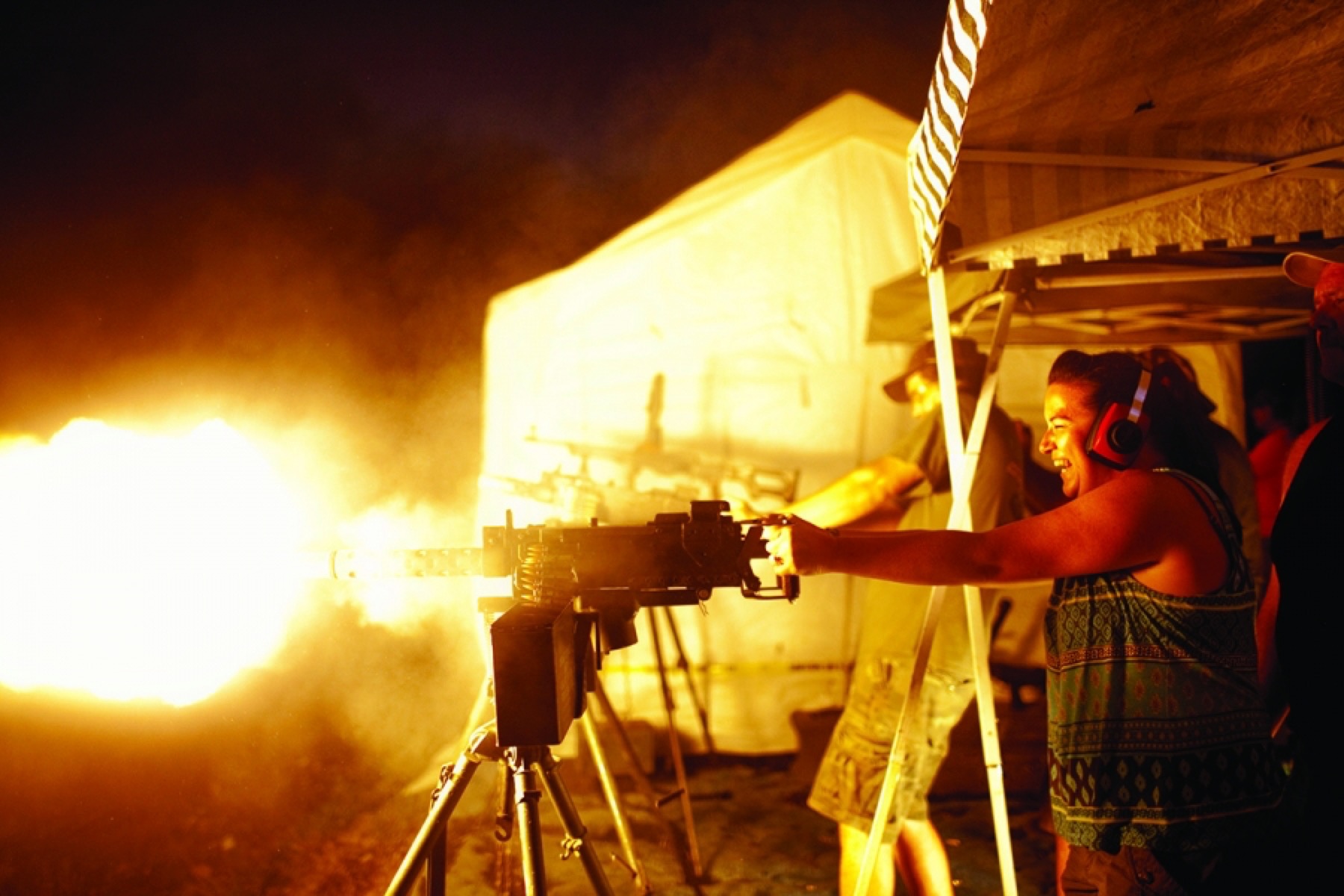
Balls of Fire
By Patrick Wensink
A gravel path leads to Knob Creek and a clearing where ash and eastern redbud trees sprout purple and green, and people seated in fifteen rows of bleachers stand for “The Star-Spangled Banner.” The PA system is weak, but the singer’s voice is clear and sweet and perfect for this warm afternoon in the woods, thirty miles south of Louisville, near Fort Knox. The singer hits “O’er the ramparts,” and an explosion erupts like a thundercloud through a stethoscope. Out on the gun range, a hundred yards from the singer, a flaming plume lifts above the trees, exhaling dense black smoke. Somebody accidentally left dynamite near a smoldering bonfire in the clearing.
No matter. The audience barely flinches. The singer takes a breath and finishes the song. Accidental explosions are second-string entertainment at the Knob Creek Machine Gun Shoot—the Woodstock of Weaponry—where ordinary folks unload combat Uzis and belt-fed artillery fit for B-52 tail gunners, all for the pleasure of a screaming crowd. More than 15,000 spectators will stake out the best vantage point for this three-day war zone, the largest event of its kind in America.
Beneath the canopy of blooming trees, Knob Creek’s gun range is massive, a couple of football fields wide, a muddy notch carved into tobacco-brown hills and littered with DIY targets: fifty-gallon metal drums, a barbecue grill, an oven, propane tanks, a child’s ATV, multiple speedboats. A blue Ford Explorer and a mid-’90s Subaru station wagon both stand on a pedestal. Each target is loaded with a charge of diesel fuel or TNT, depending on whom you ask. The announcer promises “fireballs from hell,” and after “The Star-Spangled Banner” the Knob Creek security officers raise green paddles, a signal for silence from the crowd. Bullfrogs growl in the woods and twenty shooters lock and load an assortment of AK-47s, belt-fed MG 42s, and other automatic weapons. There is an excitable tension in the air that feels more like those few seconds before a Kentucky Wildcats tipoff than an afternoon at the gun range. I push in my earplugs.
The initial force of the Shoot is impressive. Rapid, high-caliber barks weave together with compressed, low-caliber snaps and form a textured wall of sound not unlike jet engine thrust. The bottlerocket smell of burnt gunpowder fills my nostrils, and a faraway speedboat, midway along the sloping hill, detonates into a wild orange blaze. Closer in, chunks of raw soil and chips of refrigerator door dance through the air. Sparks fly from the Subaru and the Ford raised six feet off the ground. As the cars disintegrate behind filthy clouds of smoke and dirt, the shooting spree continues. The gunfire has morphed into a sort of heavy ballistic white noise and I am struck by how normal it all seems. An exploding dishwasher in any other context would send my blood pressure into uncharted territory. But after thirty minutes of destruction, the gunfire and explosions feel oddly pedestrian. The army of security guards raises red paddles, and the cacophony slows to nothing. There is a breath of silence before the crowd unleashes a cheer that rivals the gunfire in terms of sheer volume.
The haze lifts and I see the targets have become shrapnel; there are more open flames on the range than I can count. Forklifts and four-wheelers haul away the wreckage. The demolition crew brings in fresh cars, a water heater filled with diesel, and the aqua fiberglass shell of an in-ground swimming pool. The sun is beginning to set and there are still two more sessions today, two more chances to experience fireballs from hell, two more opportunities for the people to erupt in a muscular howl, whooping into the smog-swathed clearing in the woods as though the demolition has resurrected something inside of them.
The urge to unload some lead into a hatchback or water heater is hard to deny. I am not a gun owner, but am reminded of the pleasure of shooting cans with a pellet gun. I wander down to the machine-gun rental booth. For $150, I can rent a gun of my own loaded with fifty bullets, about one minute’s worth of entertainment at Knob Creek. I keep walking.
Like this story? Subscribe to the Oxford American.

